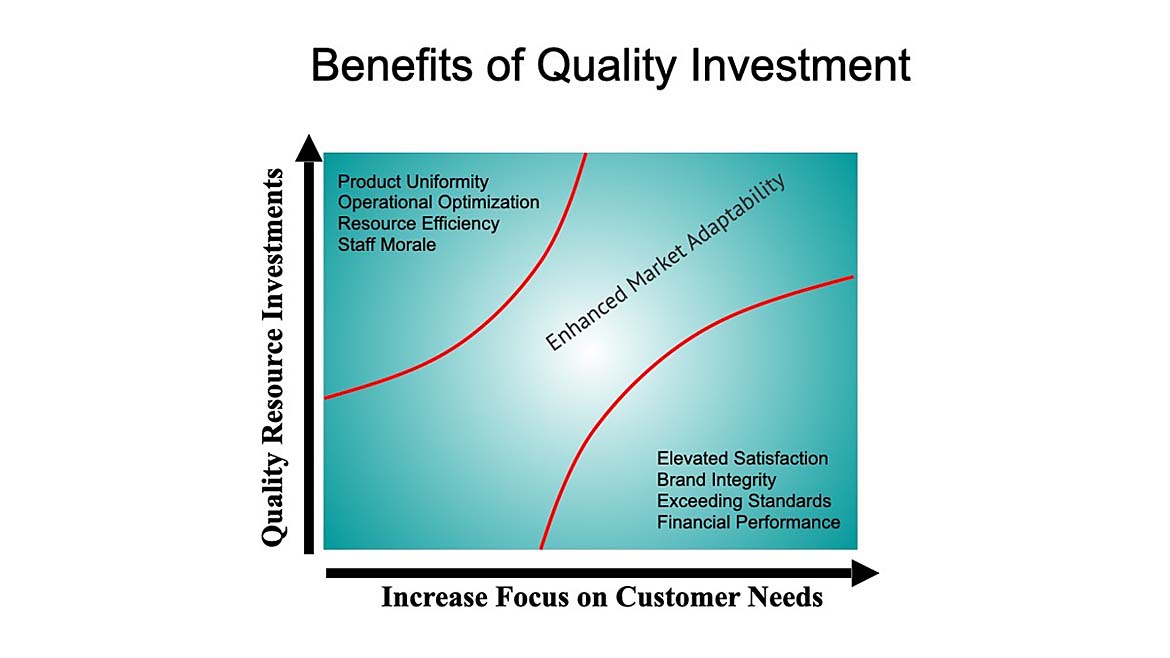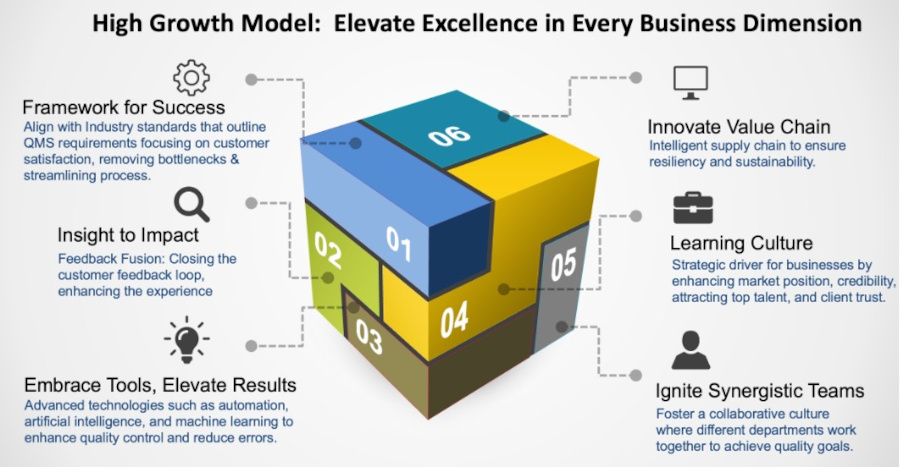The Benefits of Quality Investment
Investing resources in quality as a primary focus rather than as a secondary expenditure is crucial for the long-term success and sustainability of an organization. Quality should be viewed as a strategic investment that yields high growth rates versus a departmental cost that is burdensome to the business. Prioritizing quality in the organization builds a strong framework and foundation for customer satisfaction, consistency, trust, and customer loyalty. Proactively prioritizing and investing in quality reduces the likelihood of waste, product defects, customer complaints, and overall error. Committing to a quality framework fosters a culture of continuous improvement within the business, drives innovation in the company workforce and improves overall operational efficiency, which generates value for the company. As customer expectations grow and advance, businesses that invest in a quality framework and foundation vs businesses that are focused on merely outdoing their competitors are in a better position to achieve higher growth rates, a competitive edge, and establish a premium brand. In fact, companies that strive for quality and their business goals are likely to achieve both quality and their business goals. However, companies that have business goals positioned first and quality as secondary or optional are likely to achieve neither the business goal nor quality. (2)
Quality management systems, such as ISO 9001, establish clear communication structures that delineate responsibilities and assign quality tasks across all departments. This quality foundation laid in a company fosters higher employee morale, improved performance, and operational increased efficiency.
With today’s saturated market and endless options, customers have more nuanced needs than ever before and seek partnership versus outdated transactional relations. Quality is no longer an option for client satisfaction and retention, it is imperative.

Brand reputation must evolve with customer sentiment and the customer’s power of choice, therefore companies must develop quality systems that help them tune into unique user preferences and experiences. Businesses that invest in a quality management system are wise in doing so and understand that prioritizing quality in their products ensures customer satisfaction and repeat business.
Management
Related Article
Implementing robust quality management practices is a challenge that requires investment, dedication, and buy in from leadership. The impact of a single defective product or poor service on a business is significant. A business will feel the loss in a number of ways. Shared negative experiences, unfavorable reviews, and returned items or refund requests, and customer’s pulling out of a project. Business owners shoulder the costs of product recalls and, in the worst-case scenario, may face lawsuits. Companies cannot afford to underestimate the importance of a quality management system. Proactive investment in quality management upfront help businesses avoid risks. This approach safeguards the brand’s reputation by identifying risk early and addressing potential issues before products or services are delivered. (2)(3)(4)
Elevating Excellence

01 – Framework for Success
A strong commitment to quality, supported by the establishment of a quality management system (QMS), can be a powerful marketing tool. Businesses that prioritize quality are as a reliable and trustworthy choice and attracts new and repeating customers. As a company grows in size and clientele, customer audits, feedback, customer complaints, security concerns, and certification needs increase. Suddenly, these concerns become an organization’s priority. Without a quality management system driving the business, process, voice of the customer, measuring risk, and operations are not standardized and tracked to facilitate continuous improvement. Often in smaller companies where there is not a QMS, executives and leaders are overly burdened with tasks and activities that can be easily delegated and managed by basic quality management systems. Instead of disorganized processes and bottlenecks, many activities can be shared and delegated throughout an organization with a basic QMS model. ISO 9001, an international standard, outlines the basic requirements of a quality management system centered around customer satisfaction. Implementing this framework removes bottlenecks and streamline process and activities throughout an organization. Creating a scalable and flexible QMS as an organization grows will position a company for success as operations become efficient and the business understands where they need to improve based off the Voice of the Customer. Establishing a QMS is no longer a question of if, but a matter of when.(2)(4)(5)
02 – Insight to Impact
Responding effectively to customer feedback is a business necessity. A business is affected by how quickly it can assess and respond to customer feedback. Successful companies invest in the appropriate systems that reduce average investigation and closure cycle times and the capability to predict and address negative trends in product/service performance.
Customer feedback should be handled through a closed-loop process that provides meaningful data to support continuous improvements for all business units. The feedback data should always be meaningful and useful to management and other investigative teams to make sound business decisions. Collecting feedback data without using it to fuel continuous improvement initiatives is wasteful and shortsighted.
The customer feedback loop is a company’s defense against systematic issues and potential complaints. Therefore, it should be recognized as a core business process that drives continuous improvement and increases the bottom line. Investing in a robust issue management database will ensure that a organization can properly intake, manage, and resolve internal and external issues. (2)(4)
03 – Embrace Tools, Elevate Results
Companies that invest in automation, artificial intelligence, and machine learning to enhance quality and reduce waste are ahead of the game. Using A.I., predictive analytics, and real-time monitoring improves accuracy and efficiency in processes. Leveraging these tools saves companies money in the long run and creates a competitive advantage in the market. Advanced technologies automate repetitive and time-consuming manual tasks. This efficiency can lead to increased productivity and cost savings. Unlike manual processes, using tools and technology are less prone to errors. This reduction in errors can save money by preventing costly mistakes, rework, and the associated expenses. Advanced technologies are scalable, meaning they can handle larger volumes of work without a proportional increase in costs, while manual processes may require additional labor and resources as the workload increases. Most importantly, adopting advanced tools can provide valuable insights through data analytics, helping organizations make data-driven decisions. Manual processes are time consuming and may lead to missed opportunities or inefficiencies. (5)
04 – Learning Culture
Cultivating a learning culture to position the business for success in a competitive market is crucial. Investing in employee training and development can have a positive and significant impact on overall quality within an organization and encourages employees to seek ongoing improvement. A learning culture fosters innovation and a commitment to quality throughout the organization. Increased skills lead to higher-quality work and improved performance in job roles. By investing in training employees learn to use tools and new technologies, reducing errors ultimately contributing to higher-quality outcomes. Employee skill certification is another way a business can ensure a standardized and recognized level of expertise, promoting consistency and reliability in the workforce. Promoting employee certifications publicly even serves as a strategic driver for businesses by enhancing their market position, building credibility, attracting top talent, fostering client trust, and creating valuable marketing and partnership opportunities in the market. (2)(5)
05 – Ignite Synergistic Teams
Collaboration is the key ingredient to building out a successful quality framework in an organization. Synergistic teams drive the building and operationalizing of an integrated quality management system. Without collaboration, quality activities get siloed to a quality department, which is not ideal for a business that wants to achieve ultimate customer satisfaction and growth. With persistent collaboration between business units, quality tasks and activities are dispersed throughout the organization and teams begin building with the same blocks. This collaborative environment promotes operational efficiency and keeps the business moving forward. Essentially, quality should drive the business and all hands should be on-deck. Quality is not just a department, it is a mind-set the entire organization needs to adopt. (5)(6)
06 – Innovating across the Value Chain
The supply chain of the future will connect decisions to automated execution across the value chain. Supply chain resiliency is built on backs of strong relationships business to business. In the past three years there have been many disruptions related to supply chain. Geopolitical conflicts, cyber security risks, inflation, and economic conditions are a few examples of disruptions that have impacted the flow of goods, availability of goods, and price surges. Some overarching weaknesses that have led to supply chain disruption are around lack of supply chain planning their capabilities leading to poor risk mitigation and missed opportunities, agility to effectively respond to the unexpected, and lack of end-to-end visibility.
And intelligent supply chain leverages technology, predictive analytics, and artificial intelligence to enhance efficiency, real-time visibility and data driven decision-making. (4)(5)(6)
It empowers organizations to make data-driven decisions, enhance operational efficiency, manage risks effectively, and ultimately deliver a superior customer experience, all of which are critical factors in the rapidly evolving landscape of logistics and supply chain management. Innovating around the value chain has become a “must” in this emerging market. As we head into the future, adopting these technologies and enhancing supply chain practices are the only ways around these supply chain disruptors to ensure resiliency and sustainability. (7)
Commit to Long-Term Sustainability
Organizations that prioritize quality are likely to be more sustainable in the long term than companies that prioritize quality as a secondary goal. The pursuit of quality is not isolated but rather integral to achieving a wide range of business goals. A focus on quality must permeate throughout the organization, influencing various aspects of operations, customer relations, employee engagement, and overall business success.



